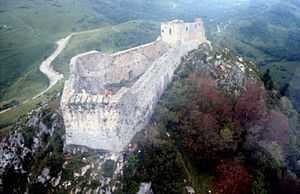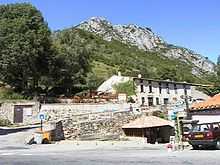Château de Montségur
| Château de Montségur | |
|---|---|
| Montségur, France | |
 | |
| The Fortress of Montségur | |
| Coordinates | 42°52′32″N 1°49′57″E / 42.87556°N 1.83250°ECoordinates: 42°52′32″N 1°49′57″E / 42.87556°N 1.83250°E |
| Site information | |
| Site history | |
| Built | 13th century |



The Château de Montségur is a former fortress near Montségur, a commune in the Ariège department in southwestern France. Its ruins are the site of a razed stronghold of the Cathars. The present fortress on the site, though described as one of the "Cathar castles," is actually of a later period. It has been listed as a monument historique by the French Ministry of Culture since 1862.
Geography
The ruins of Montségur are perched at a precarious 1,200 metres (3,900 ft) altitude in the south of France near the Pyrenees. Located in the heart of France's Languedoc-Midi-Pyrénées regions, 80 km (50 mi) southwest of Carcassonne, Montségur dominates a rock formation known as a pog — a term derived from the Languedocien dialect of Occitan — puòg or puèg, meaning "peak, hill, mountain."
History
The earliest signs of human settlement in the area date back to the stone age, around 80,000 years ago. Evidence of Roman occupation such as Roman currency and tools have also been found in and around the site. Its name comes from Latin mons securus, which evolved into mont ségur in Occitan, which means "safe hill". In the Middle Ages the Montsegur region was ruled by the Counts of Toulouse, the Viscounts of Carcassonne and finally the Counts of Foix. Little is known about the fortification until the time of the Albigensian Crusade.
The Cathar castle
In about 1204, Raymond de Péreille, one of the two lords of Montségur, the other being his cousin Pierre-Roger de Mirepoix, declared to rebuild the castle that had been in ruins for 40 years or more.[1] Refortified, the castle became a center of Cathar activities, and home to Guilhabert de Castres, a Cathar theologian and bishop. In 1233 the site became "the seat and head" (domicilium et caput) of the Cathar church.[1] It has been estimated that the fortified site housed about 500 persons when in 1241, Raymond VII besieged Montsegur without success.[2] The murder of representatives of the inquisition by about fifty men from Montsegur and faidits at Avignonet on May 28, 1242 was the trigger for the final military expedition to conquer the castle.
In 1242 Hugues de Arcis led the military command of about 10,000 royal troops against the castle that was held by about 100 fighters and was home to 211 Perfects (who were pacifists and did not fight) and civilian refugees.[1] The siege lasted nine months, until in March 1244, the castle finally surrendered. Approximately 220 Cathars were burned en masse in a bonfire at the foot of the pog when they refused to renounce their faith. Some 25 actually took the ultimate Cathar vow of consolamentum perfecti in the two weeks before the final surrender. Those who renounced the Cathar faith were allowed to leave and the castle itself was destroyed.
In the days prior to the fall of the fortress, several Cathars allegedly slipped through the besiegers' lines carrying away a mysterious "treasure" with them. While the nature and fate of this treasure has never been identified, there has been much speculation as to what it might have consisted of — from the treasury of the Cathar Church to esoteric books or even the actual Holy Grail.
Montségur is often named as a candidate for the Holy Grail castle — and indeed there are linguistic similarities in the Grail romance Parzival (circa 1200–1210) written by Wolfram von Eschenbach. In Parzival, the grail castle is called Monsalvat, similar to Montségur and with the same meaning: "safe mountain, secure mountain." The name of Raymond de Péreille, the actual historic seigneur of Montségur, has a slight similarity to the protagonist of Eschenbach's epic, the knight Parzival. In Jüngerer Titurel (1272) by Albrecht von Scharfenberg, another Grail epic, the first king of the Holy Grail is named Perilla.
Myths and legends apart, the history of Montségur actually is both dramatic and mysterious. The siege was an epic event of heroism and zealotry: a veritable Masada of the Cathar faith whose demise is symbolized by the fall of the mountain-top fortress (although isolated Cathar cells persisted into the 1320s in southern France and northern Italy).
The later fortress
The present fortress ruin at Montségur is not from the Cathar era. The original Cathar fortress of Montségur was entirely pulled down by the victorious royal forces after its capture in 1244. It was gradually rebuilt and upgraded over the next three centuries by royal forces. The current ruin so dramatically occupying the site, and featured in illustrations, is referred to by French archeologists as "Montsegur III" and is typical of post-medieval royal French defensive architecture of the 17th century. It is not "Montsegur II," the structure in which the Cathars lived and were besieged and of which few traces remain today.
This is a discrepancy that the French tourist authority underplays and one that Cathar enthusiasts often overlook, especially when discussing Montségur's alleged solar alignment characteristics said to be visible on the morning of the summer solstice. This often mentioned solar phenomenon, allegedly occurring in an alignment of two windows in the fortress wall, has not been scientifically surveyed, measured, recorded, or confirmed.
The Groupe de Récherches Archéologiques de Montségur et Environs (GRAME) (Archeological Research Group of Montsegur and Vicinity), which conducted a definitive 13-year archeological excavation of Montségur in 1964–76, concluded in its final report that:
- "There remains no trace within the current ruin of the first fortress which was abandoned before the 13th century (Montsegur I), nor of the one which was built by Raymond de Péreille around 1210 (Montsegur II)..." (Il ne reste aucune trace dans les ruines actuelles ni du premier château qui était à l'abandon au début du XIIIe siècle (Montségur I), ni de celui que construisit Raimon de Pereilles vers 1210 (Montségur II)...)[3]
The small ruins of the terraced dwellings, immediately outside the perimeter of the current fortress walls on the north-eastern flank are, however, confirmed to be traces of authentic former Cathar habitations.
Media
- Iron Maiden published a song titled "Montségur", about the Catholics' stakes of Cathars, on their 2003 album Dance of Death.
- German thrash metal band Paradox's album Heresy deals with the persecution of the Cathars.
- The Era albums allude to the history of the Cathars, and the first album mentions Montségur on its cover.
- In Peter Berling's pentalogy The Children of the Grail and in Julia Navarro's La sangre de los innocentes, the siege of Montségur is described.
- In Dan McNeil's novel The Judas Apocalypse, set just after the landings at Normandy during the Second World War, a German archaeologist and a group of American soldiers go looking for the Cathar treasure that was removed from Montségur.
- Sylvie Miller & Philippe Ward's novel The Song of Montségur (Le Chant de Montségur, 2001) pits the Roman Catholic Church against an ancient secret society of Nazis looking for the Holy Grail in Montségur. ISBN 978-1-935558-56-9
- Kathleen McGowan's novel "The Expected One" incorporates the story of the Siege of Montsegur in the telling of Cathar history.
- Kate Mosse's novel, 'Labyrinth' also describes the besieging of the Cathars at Montsegur and explains some aspects of the connection between the Cathars and the Grail Legend
See also
- Albigensian Crusade
- Cathar castles
- Cathars
- Otto Rahn
- List of castles in France
- List of medieval bridges in France
- Communes of the Ariège department
References
- ↑ 1.0 1.1 1.2 Claude Lebédel. Understanding the tragedy of the Cathars. Editions Ouest-France, 2011. p. 104ff. ISBN 978-2-7373-5267-6.
- ↑ Sumption, Jonathan (1978). The Albigensian Crusade. Faber and Faber. p. 237. ISBN 0-571-20002-8.
- ↑ Montségur: 13 ans de recherche archéologique. Lavelanet: Groupe de Recherches Archéologiques de Montségur et Environs (GRAME),. 1981. p. 76.
External links
| Wikimedia Commons has media related to Montségur. |
- Ministry of Culture database entry for Château de Montségur (French)
- Photos of Montsegur
- Ministry of Culture photos
- Montsegur and the Cathar Heresy
- The paths of Cathars by the philosopher Yves Maris.
- The Trail of Gnosis by Judith Mann